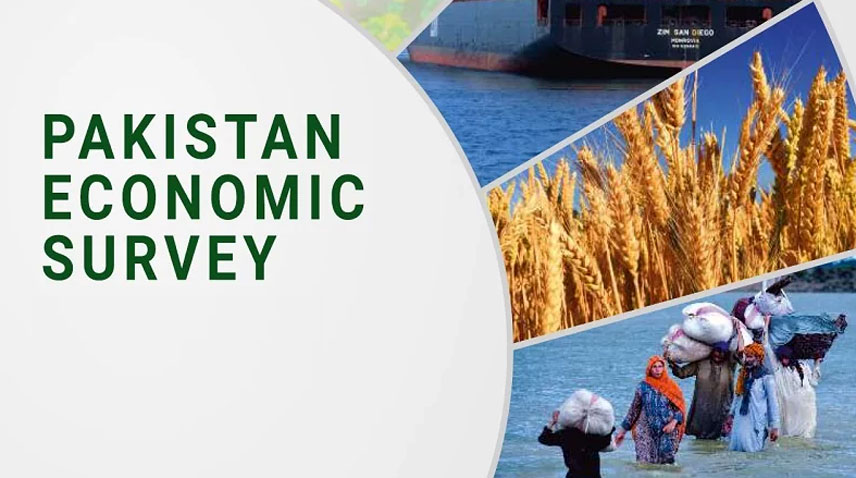Islamabad, June 10, 2025: The federal government has released the Pakistan Economic Survey 2024–25, detailing economic performance over the past year. While prominent improvements were observed in inflation control, remittances, and public revenues, setbacks in agriculture and manufacturing continued to weigh on overall growth.
Agricultural Sector Posts Mixed Performance
The agriculture sector managed to grow by 0.56%, mainly supported by the livestock sub-sector. However, the sector’s contribution to GDP fell to 23.54%, compared to 24.03% in FY2024.
Major crops witnessed a significant reduction of 13.49%, due to reduced cultivation area and unfavorable weather conditions. Cotton production dropped by 30.7%, maize by 15.4%, and wheat by 8.9%. Meanwhile, minor crops showed flexibility, growing by 4.78%, with increases in potatoes, onions, and mash pulses.
The livestock sector increased by 4.72%, continuing to serve as a major pillar, contributing 14.97% to national GDP. Forestry and fisheries also showed modest growth at 3.03% and 1.42%, respectively.
GDP Growth Steadies at 2.68%
The national economy grew by 2.68% in FY2025, demonstrating stabilization across key indicators. The industrial sector grew by 4.77%, while the services sector, which remains the largest contributor to the economy, expanded by 2.91%, maintaining a 58.40% share in GDP.
At current market prices, GDP rose to Rs114.7 trillion, showing a 9.1% increase from the previous fiscal year. Investment and saving indicators improved, with the investment-to-GDP ratio rising to 13.8% and the savings rate reaching 14.1%.
Budget Deficit Narrows as Revenues Surge
The fiscal deficit was 6.5% of GDP, a decrease from 7.4% the year prior. Government revenues totaled Rs10.8 trillion, a 29% rise, with tax income increasing by 38%. However, current spending also surged 26%, driven by growing debt servicing costs.
Inflation Eases to Record Lows
Inflation saw a sharp fall, dropping to 0.3% in April 2025 from 17.3% a year earlier. The average inflation rate for July to April stood at 4.7%, compared to 26.0% in the same period last year. The State Bank reduced the policy rate to 17.5%, down by 450 basis points since July 2024.
External Sector Shows Strength
Per capita income increased to $1,824, up 9.7% from the previous year. The current account posted a $1.2 billion surplus, equal to 0.3% of GDP. Overseas remittances grew by 11%, totaling $32 billion, and foreign exchange reserves climbed to $14.3 billion, enough to cover 3.6 months of imports.
Health and Education Remain Underfunded
Infant mortality decreased to 52 per 1,000 live births, down from 56, but public health spending remained limited to 1.4% of GDP. The literacy rate rose to 62.8%, while primary school enrollment hit 28.6 million. However, education spending stayed low at 2.1% of GDP.
IT Sector Shines in Tech Expansion
The information technology sector emerged as a top performer, with exports rising 32% to $3.5 billion. Digital banking saw explosive growth of 89%, with total transactions reaching Rs12.7 trillion. Mobile broadband now covers 57% of the population, though rural connectivity gaps persist.
Demographic Shifts and Employment
The country’s population grew by 2.4%, reaching 241.5 million, with urban residents now forming 40.1% of the total. Labor force participation remained unchanged at 37.2%, with a continued imbalance in male and female employment rates.
Energy Production Up, But So Are Costs
Pakistan’s total power generation capacity climbed to 46,605 MW, marking a 1.6% increase. However, consumers continue to pay between Rs2.5 and Rs2.8 trillion annually in capacity charges for unused electricity.
READ MORE: Economic Survey 2025: Pakistan Literacy Rates Update
Debt Reduced Slightly; Stock Market Booms
The country’s total public debt dropped to 74.1% of GDP, standing at Rs67.8 trillion. Of this, Rs41.4 trillion was local borrowing and Rs26.4 trillion external.
Meanwhile, the Pakistan Stock Exchange saw a 50% increase in market value, reaching Rs10.2 trillion, and the KSE-100 index jumped 78,000 points over the fiscal year. Corporate bonds issuance also grew by 38%, reaching Rs480 billion.
READ MORE: Economic Survey 2025 Reveals the Most Populous City in Pakistan
Industry Rebounds Unevenly; Mining Mixed
While the industrial sector showed recovery, large-scale manufacturing (LSM) remained under pressure. Automobile production rebounded by 42%, but cement output declined 7.2%.
The mining industry posted 2.1% growth, with coal production rising 12%. However, mineral exports declined by 9%, and chromite output fell 18%, though rock salt increased by 5%.
Call for Human Development Investment
Finance Minister Muhammad Aurangzeb, presenting the report, stated, “Our digital transformation is accelerating, but human development needs matching investment.” The upcoming federal budget is expected to address ongoing gaps in maternal healthcare, secondary school enrollment, and gender equity in the workforce.









